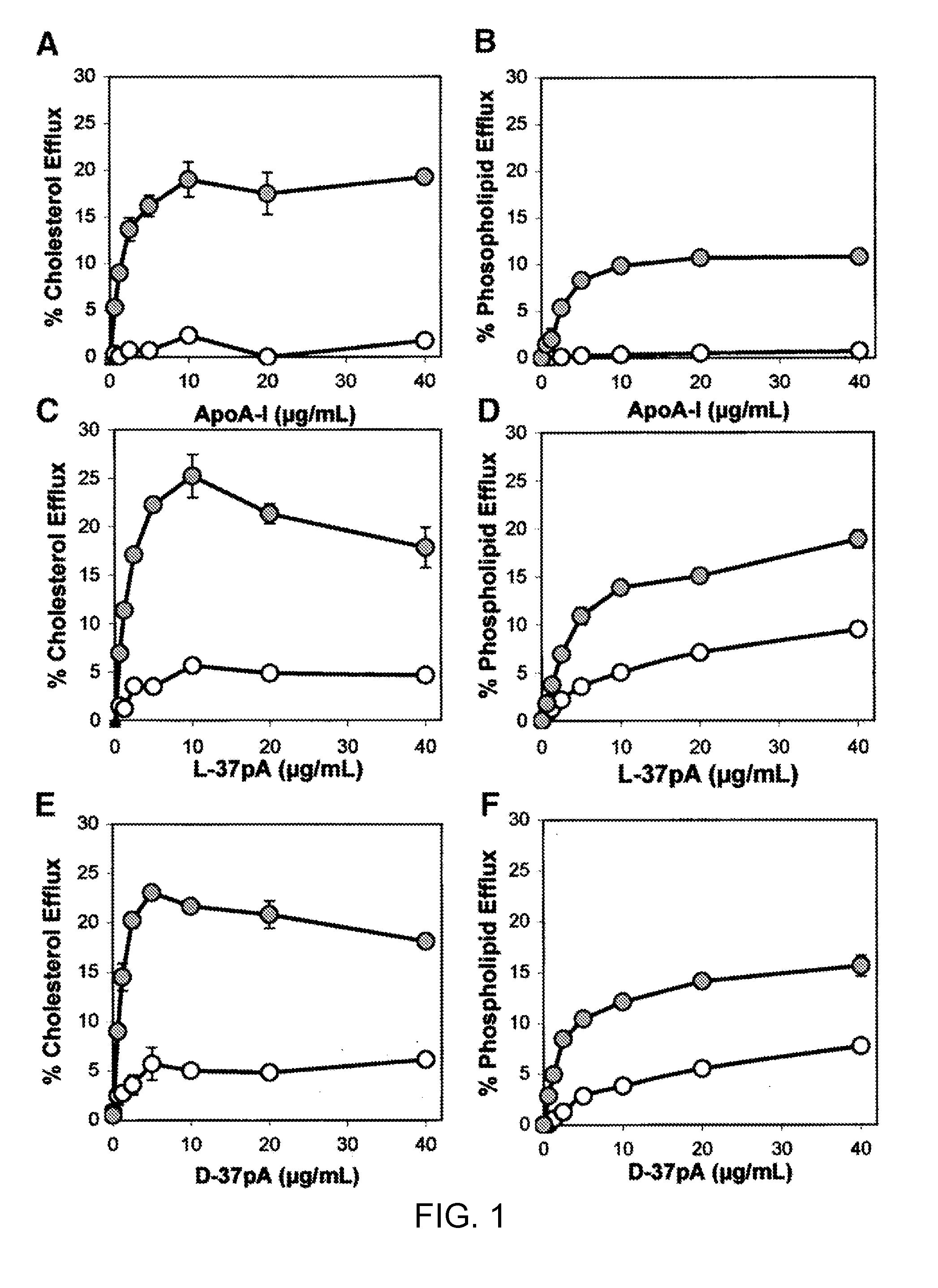Multi-domain amphipathic helical peptides and methods of their use
a technology of amphipathic helical peptides and amphipathic helical domains, which is applied in the direction of peptide/protein ingredients, drug compositions, metabolic disorders, etc., can solve the problems of potentially cytotoxic, unrecognized interaction nature of apoa-i and abca1, and achieve higher lipid affinity and promote lipid efflux
- Summary
- Abstract
- Description
- Claims
- Application Information
AI Technical Summary
Benefits of technology
Problems solved by technology
Method used
Image
Examples
example 1
Lipid Efflux from Cells Mediated by Synthetic Peptides
[0154]This example demonstrates the ability of synthetic peptides containing amphipathic helices to efflux lipid from ABCA1-expressing cells.
[0155]HeLa cells stably transfected with human ABCA1 cDNA (ABCA1 cells) and HeLa cells transfected with only a hygromycin-resistant control plasmid (control cells) were produced and grown in α-modified Eagle's medium (αMEM) plus 10% fetal calf serum, as described by Remaley et al. (Biochem. Biophys. Res. Commun. 280:818-823, 2001). Cholesterol and phospholipid efflux was performed for 18 hours on noncholesterol-loaded cells radiolabled with either cholesterol or choline (Remaley et al., Arterioscler. Thromb. Vasc. Biol. 17:1813-1821, 1997). Percentage efflux was calculated after subtracting the radioactive counts in the blank media (αMEM plus 1 mg / ml of BSA), and expressed as the percent of total radioactive counts removed from the cells during the efflux period.
[0156]Cell fixation was perfo...
example 2
Lipid Efflux Time Course
[0159]This example demonstrates the cholesterol efflux time course from ABCA1-expressing cells to apoA-I and synthetic peptides containing amphipathic helices.
[0160]Cholesterol efflux from ABCA1 cells to apoA-I was first detectable after 2 hours and continued to increase throughout the 30 hour efflux period (FIG. 2A). In contrast, there was no significant increase above background in cholesterol efflux to apoA-I from control cells (FIG. 2B). Overall, the kinetics for cholesterol efflux to L-37pA from ABCA1 cells was similar to that of apoA-I, except that cholesterol efflux was first detectable after 30 minutes (FIG. 2A). L-37pA peptide, unlike apoA-I, also promoted cholesterol efflux from control cells but at approximately half the rate (FIG. 2B). A small amount of cholesterol efflux to L-37pA from control cells was first detectable at 30 minutes, and then it slowly continued to increase throughout the efflux period, similar to what was observed for L-37pA wi...
example 3
Importance of Amphipathic α Helices
[0161]This example demonstrates the importance of amphipathic α helices in peptide-lipid affinity and in the ability of peptides to promote lipid efflux from cells.
[0162]The introduction of D-amino acids into a peptide that otherwise contains L-amino acids is known to interfere with the ability of a peptide to form an alpha helix (Chen et al., J. Pept. Res. 59:18-33, 2002). In order to test the importance of amphipathic alpha helices in peptide lipid affinity and in the ability of peptides to promote lipid efflux from cells, the following 2 peptides with the same sequence as 37pA were made with a mixture of L- and D-amino acids: (1) L2D-37pA, all L-amino acids except that D-amino acids were used for valine and tyrosine; and (2) L3D-37pA, all L-amino acids except that D-amino acids were used for alanine, lysine, and aspartic acid. The L2D-37pA and L3D-37pA peptides had lower lipid affinity, as assessed by monitoring their ability to act as detergent...
PUM
| Property | Measurement | Unit |
|---|---|---|
| concentration | aaaaa | aaaaa |
| concentration | aaaaa | aaaaa |
| concentration | aaaaa | aaaaa |
Abstract
Description
Claims
Application Information
 Login to View More
Login to View More - R&D
- Intellectual Property
- Life Sciences
- Materials
- Tech Scout
- Unparalleled Data Quality
- Higher Quality Content
- 60% Fewer Hallucinations
Browse by: Latest US Patents, China's latest patents, Technical Efficacy Thesaurus, Application Domain, Technology Topic, Popular Technical Reports.
© 2025 PatSnap. All rights reserved.Legal|Privacy policy|Modern Slavery Act Transparency Statement|Sitemap|About US| Contact US: help@patsnap.com



